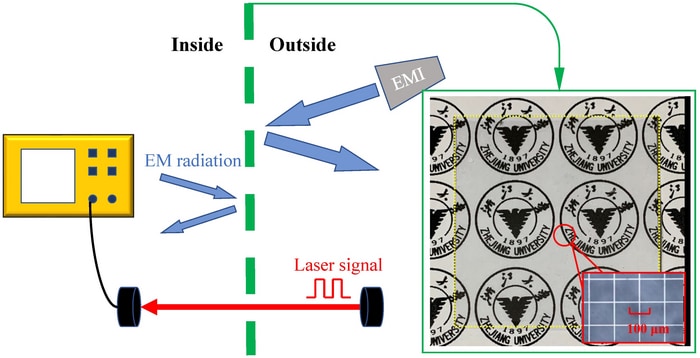
A flexible, transparent material that blocks electromagnetic interference (EMI) while allowing high-quality infrared wireless signals to pass efficiently through could be employed in free-space optical communications applications that require EMI shielding. The material, made of a silver mesh on a polymer substrate, is self-cleaning and resistant to corrosion, enabling its use in both indoor and outdoor settings.
Electromagnetic radiation from different electronic devices can interfere and adversely affect device performance. EMI shielding is often used to prevent this, but the shielding can also block the wireless signals required for communications. What’s more, many conventional transparent EMI shields only allow visible signals to pass through, which are not suitable for wireless optical communications because of the large background noise at these wavelengths. A shield that is transparent over a broad wavelength band covering the important near-infrared or mid-infrared optical communications range would be better, but has been lacking so far.
The new device, made by Liu Yang and colleagues from Zhejiang University in China, can for the first time, efficiently shield EMI in the X band (a frequency band in the microwave region) with an average shielding effectiveness of up to 26.2 dB, while allowing high light transmission in a broad wavelength range from 400 to 2000 nm.
The researchers fabricated silver meshes with thicknesses of up to 220 nm on a transparent and flexible polyethylene substrate using standard microprocesses including ultraviolet lithography, physical vapour deposition and lift-off, all of which are precisely repeatable and scalable. They then covered the mesh with a 60-µm-thick layer of polydimethylsiloxane to prevent chemical corrosion and improve mechanical flexibility. This layer also allows the mesh to be “self-cleaning”, says Yang.
“High-quality free-space optical (wireless) communication mainly benefits from the high transparency and low haze at the optical communications wavelength of 1550 nm,” she tells Physics World. “Thanks to the low sheet resistance of our silver mesh, the incident electromagnetic wave is mainly reflected with little transmitted. This means a high shielding effectiveness.”
The technology could be used whenever both EMI shielding and remote communications are required at the same time. And thanks to the fact that it is stable to chemicals, mechanically flexible and self-cleaning, the silver mesh could be widely employed both indoors and outdoors – even on corrosive and free-form surfaces, explain the researchers.
They do admit, however, that the structure, which is detailed in Optical Materials Express, is only a prototype and there is much room for improvement. “Materials that are more conductive, more transparent and which have a lower haze are needed, especially at optical communications wavelengths,” says Yang.
“As discussed in our publication, exploring materials to extend the free-space optical communications to longer wavelengths is also a future research direction because atmospheric interferences can be greatly reduced in the mid-infrared regime. A much higher communication may thus be achieved.”


